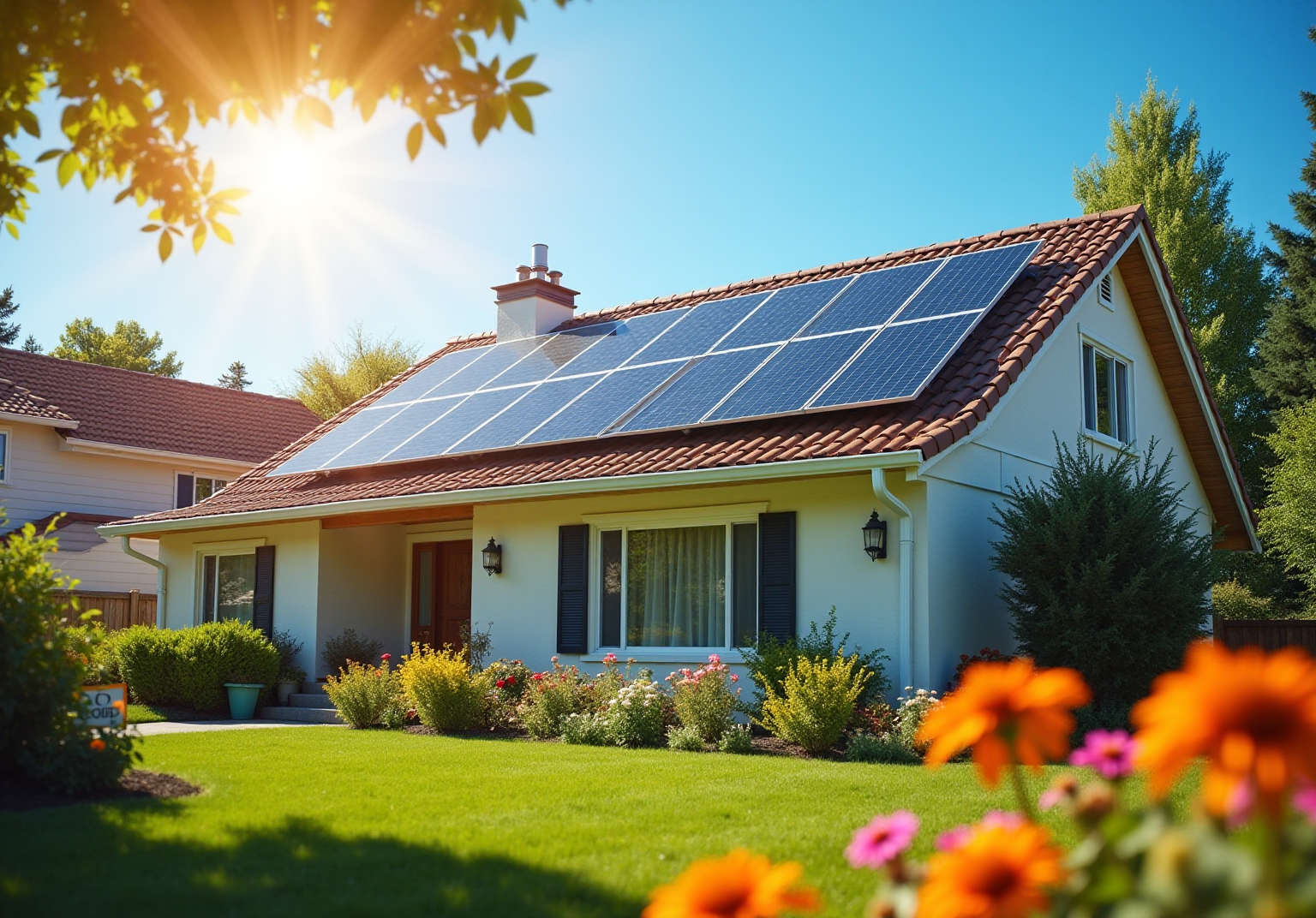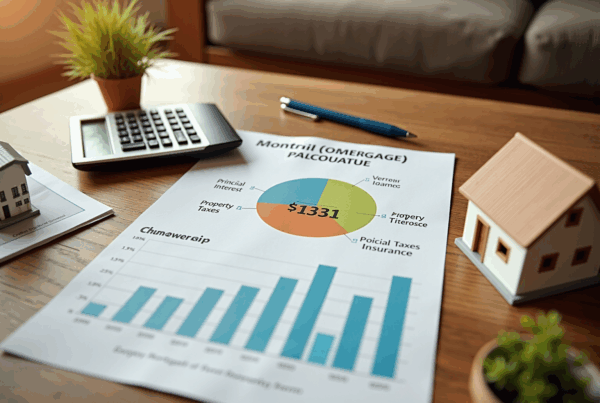Overview
Are you considering ways to enhance your home’s value? Solar energy installations might be just the solution you’re looking for. Studies show that homes equipped with solar panels can increase in value by approximately 5% to 10%. In fact, these homes tend to sell for an average of 6.9% more than those without solar energy.
We understand how important it is for families to make smart financial decisions. The compelling financial benefits of solar energy extend beyond just resale values. Homeowners can enjoy significant long-term energy savings, making solar a wise alternative to traditional home improvements.
Imagine the peace of mind that comes with knowing you’re not only investing in your home but also contributing to a sustainable future. By choosing solar energy, you’re taking a step toward financial stability while also caring for the environment.
If you’re ready to explore this option further, we’re here to support you every step of the way. Let’s work together to make your home more valuable and energy-efficient.
Introduction
Recent research highlights an important trend: homes equipped with solar energy systems often achieve higher market prices than those relying solely on traditional upgrades. With potential increases in property value ranging from 5% to 10%, the financial implications can be significant, especially in areas with high electricity costs.
As homeowners navigate the decision between solar energy and conventional renovations, it’s natural to have questions. Do the long-term savings and environmental benefits of solar truly outweigh the immediate aesthetic appeal and return on investment of traditional improvements?
Exploring this dynamic not only sheds light on the value of energy-efficient upgrades but also reveals the complexities that influence a home’s marketability. We know how challenging this can be, and we’re here to support you every step of the way.
Impact of Solar Panels on Home Value
Recent studies reveal that photovoltaic panels can significantly enhance a property’s value, leading to the conclusion that solar increases home value, typically increasing it by 5% to 10%. For instance, a notable Zillow study found that homes with solar energy sold for an average of 6.9% more than their non-solar counterparts, which raises the question of whether solar increases home value, translating into financial benefits of approximately $25,000 to $29,000.
This increase can lead to substantial financial advantages, especially in regions with high electricity costs, where homes equipped with solar technology often sell faster than similar properties lacking these features, highlighting the question of whether solar increases home value. Additionally, photovoltaic systems contribute to long-term savings on energy expenses, making these properties even more appealing to prospective buyers.
The combination of these financial benefits, along with the decreasing cost of photovoltaic installations—from $3.80 per watt to $2.50 since 2014—and the growing demand for eco-friendly living solutions, positions these installations as a valuable enhancement that offers a strong return on investment.
However, we understand that potential buyers should also consider challenges such as the implications of rented energy systems or outstanding energy loans, which may complicate the sale process. As the percentage of U.S. homes with solar panels is projected to rise to 15% by 2030, the trend toward solar energy adoption continues to grow.
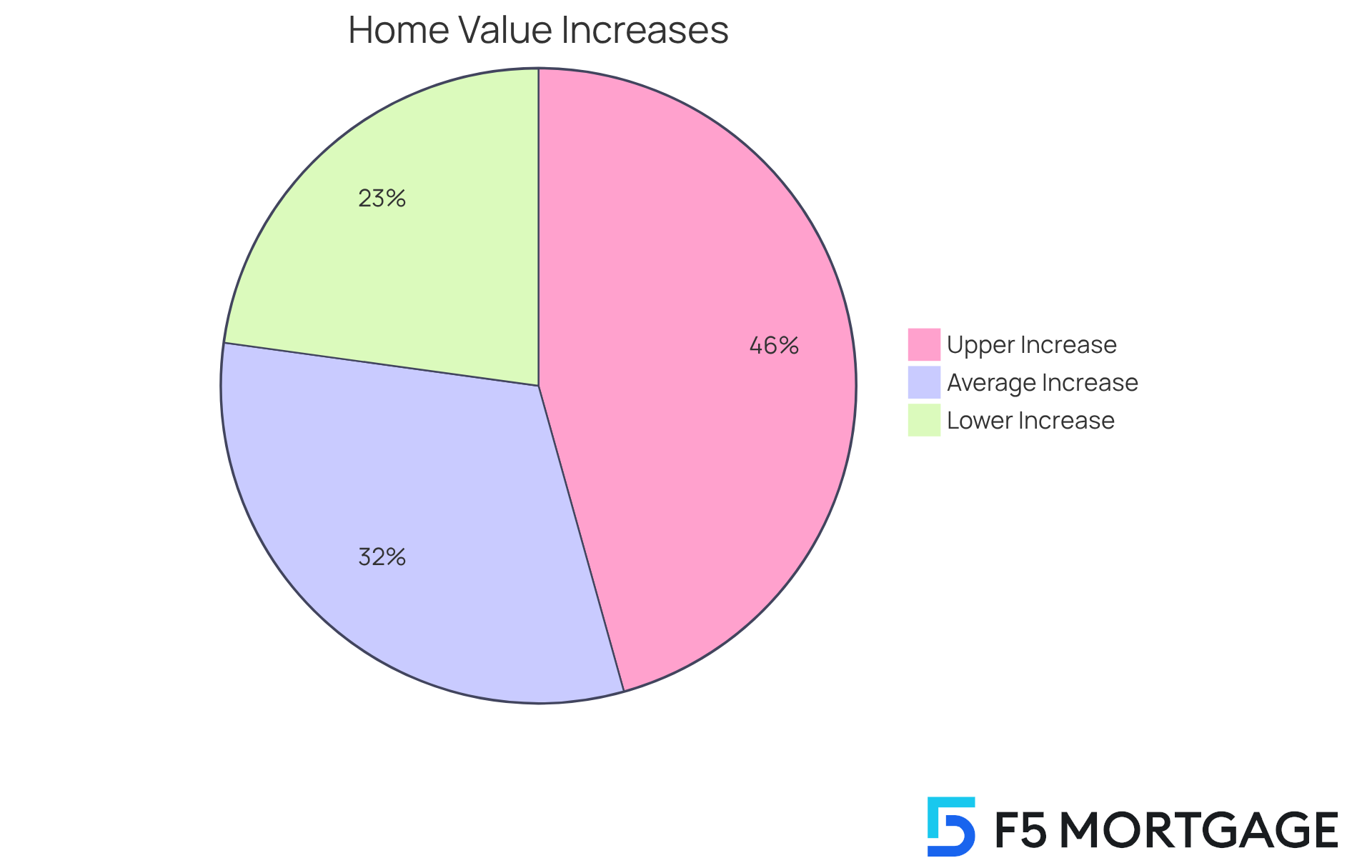
Effect of Traditional Home Improvements on Property Value
When it comes to enhancing your home, conventional property improvements like kitchen renovations, bathroom upgrades, and landscaping can truly make a difference. We know how important it is to boost your asset’s worth, and the National Association of REALTORS® highlights that kitchen remodels can yield an impressive return on investment (ROI) of up to 81%. Bathroom renovations typically return around 60% to 70%. These enhancements not only elevate the aesthetic appeal of your home but also improve its functionality, making it more inviting for potential buyers.
For instance, a mid-range bathroom renovation can recoup about 60% to 70% of its cost during resale, especially when modern fixtures and efficient layouts are incorporated. Landscaping improvements, like enhancing curb appeal through thoughtful planting and upkeep, can significantly increase your home’s resale potential. This makes them a vital consideration for homeowners looking to upgrade.
However, it’s essential to recognize that the ROI on these upgrades, including how much does solar increase home value, can vary widely based on factors such as location, market trends, and the quality of workmanship. Minor to mid-range kitchen remodels often recoup 75% to 100% of their costs at resale, underscoring the importance of careful design and execution. Interestingly, replacing a garage door offers an extraordinary average ROI of 194% nationally, showcasing that some upgrades can yield remarkable returns.
On the other hand, while photovoltaic systems provide ongoing energy savings and appeal to eco-conscious buyers, traditional enhancements may not deliver lasting financial benefits beyond the initial increase in property value, which leads to the question of does solar increase home value. Therefore, it’s crucial for homeowners to weigh the immediate aesthetic and functional benefits of traditional renovations against the sustainable savings offered by energy-efficient upgrades. These options are becoming increasingly attractive to buyers who want to save on energy bills. We’re here to support you every step of the way as you navigate these decisions.
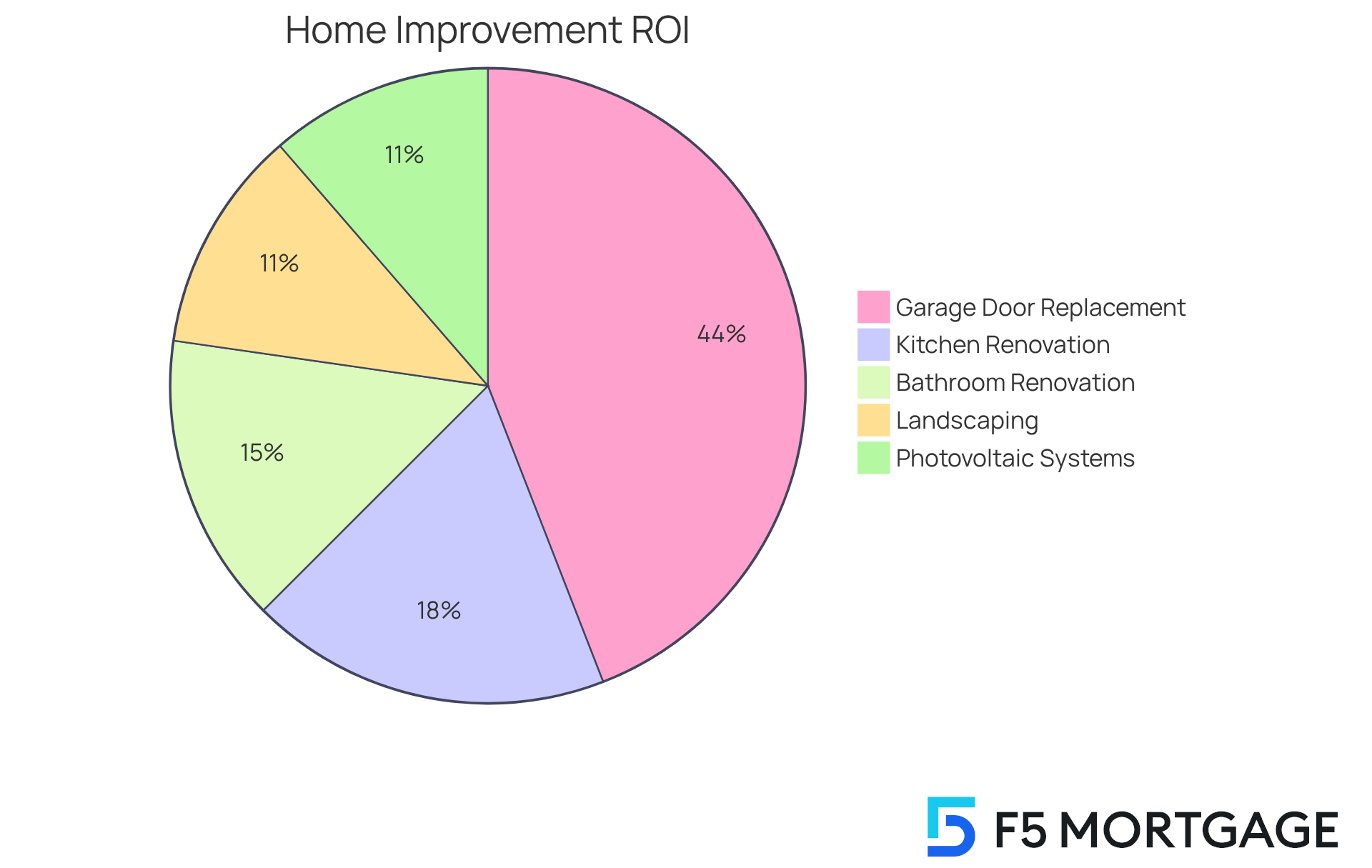
Key Factors Influencing Value Increase from Solar and Traditional Improvements
The rise in benefits from photovoltaic panels and conventional property enhancements is shaped by numerous essential elements. We understand how important it is to make informed decisions regarding your home. Position is crucial; residences located in areas with elevated electricity costs or strong renewable energy incentives generally witness greater price appreciation. For example, properties in sunny states or regions with high energy expenses frequently experience returns on investment (ROI) from photovoltaic installations ranging from 5% to 10%.
Furthermore, the ownership status of the energy system plays a crucial role. Homes with owned energy systems typically achieve higher resale values compared to those with leased systems, which can complicate sales due to ongoing financial obligations. Additionally, photovoltaic systems can provide financial and environmental advantages for 25 years or longer, establishing them as a long-term investment for homeowners. However, we know how challenging it can be to navigate property taxes; it’s important to note that residences with solar panels may also experience an increase in annual property taxes by between $160 and $630, depending on the specific installation and local tax regulations.
In contrast, conventional property enhancements also rely on various factors, including the quality of materials, the extent of renovations, and alignment with current design trends. The general state of the residence and its alignment with purchaser expectations in the local market are essential in assessing the additional worth of these improvements. For instance, top-notch renovations can produce improved returns, but they must align with prospective purchasers’ preferences to enhance their effect on property worth.
Case studies indicate that residences equipped with photovoltaic systems provide evidence that does solar increase home value, as they sold for an average of 6.9% more than those lacking them, resulting in an extra $25,000 to $29,000 in worth. This highlights the economic advantages of renewable energy investments, particularly in the question of does solar increase home value. On the other hand, in specific markets like Alabama, residences equipped with renewable energy systems sold for 5% less than their non-renewable equivalents, emphasizing the variability of such energy’s influence depending on location and market circumstances. Therefore, grasping these dynamics is crucial for homeowners contemplating renewable installations or conventional upgrades. We’re here to support you every step of the way as you consider your options.
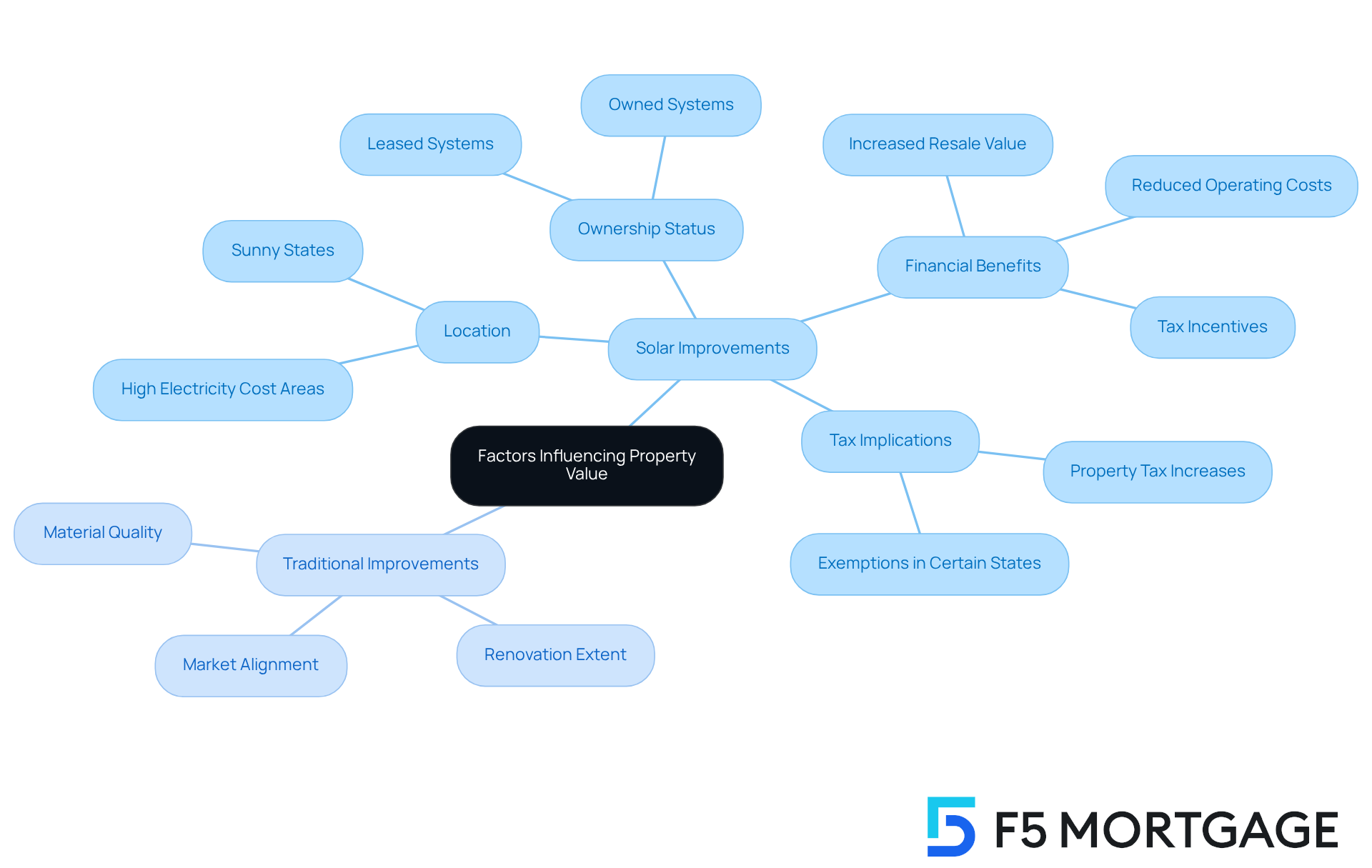
Comparative Advantages and Disadvantages of Solar vs. Traditional Improvements
When considering photovoltaic systems alongside conventional residential enhancements, it’s important to recognize both the benefits and drawbacks that can impact your decision. Solar installations are notable for their potential long-term energy savings and for providing evidence that does solar increase home value—by as much as 4.1% or around $15,000. Additionally, they contribute positively to the environment, particularly in markets that prioritize energy efficiency. Research indicates that homes equipped with photovoltaic systems can sell for an average of 6.9% more than those without, leading to the inquiry of how much does solar increase home value. Furthermore, these panels can recoup their costs within 6 to 10 years, making them a financially sound investment compared to traditional renovations.
However, we understand that the initial installation costs can be daunting, averaging about $21,600 before incentives. It’s also worth noting that the efficiency of these systems can fluctuate based on geographic location and local regulations. Thankfully, the federal solar tax credit can significantly lower these upfront expenses, making solar installations more attainable for homeowners like you.
On the other hand, traditional home improvements, such as kitchen or bathroom renovations, often provide a more predictable return on investment (ROI) and can enhance the immediate aesthetic appeal of your property. For example:
- Kitchen remodels typically recover around 60% of their costs at resale.
- Bathroom renovations recover about 50%.
However, these upgrades may not offer ongoing savings and often require more frequent updates to maintain their value.
Ultimately, the choice between renewable energy and traditional enhancements hinges on your personal priorities, financial situation, and long-term goals. We encourage you to consider factors such as potential energy savings, property value increases, and the environmental benefits of solar energy, especially regarding how does solar increase home value, alongside the immediate aesthetic and functional improvements that traditional renovations can provide. Remember, we’re here to support you every step of the way as you navigate this important decision.
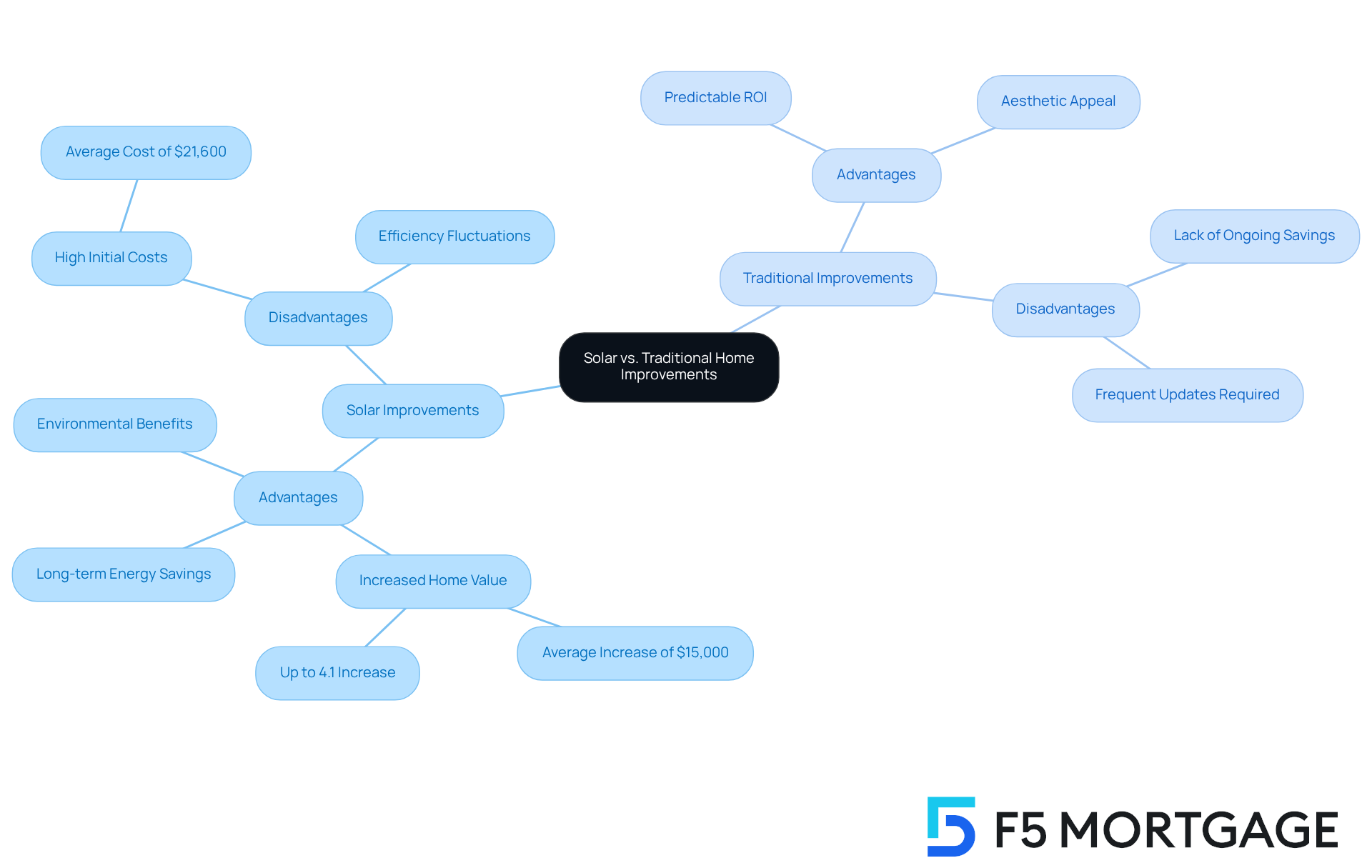
Conclusion
The exploration of solar panels versus traditional home improvements reveals a compelling narrative about enhancing property value. We understand how important it is for homeowners to make decisions that not only improve their homes but also align with their values. Solar energy systems not only contribute to a home’s financial worth but also resonate with the growing trend toward sustainability. By investing in solar technology, homeowners can expect a value increase of approximately 5% to 10%. This translates to significant financial benefits, especially in markets with high electricity costs, positioning solar energy as a valuable asset in the modern real estate landscape.
Key insights from the article indicate that:
- Traditional upgrades like kitchen and bathroom renovations offer substantial returns on investment.
- They often lack the long-term savings and environmental advantages that solar installations provide.
- Solar panels can lead to quicker sales and higher resale values, making them an increasingly attractive option for homebuyers.
Imagine the peace of mind that comes with knowing your home is not only more valuable but also more sustainable. However, we know that potential buyers must navigate challenges such as ownership status and upfront costs, which can influence their decisions.
Ultimately, the choice between solar and traditional improvements should reflect individual priorities, financial situations, and long-term goals. Embracing renewable energy not only enhances property value but also contributes to a sustainable future. As the adoption of solar energy continues to rise, we encourage homeowners to weigh the benefits of these systems against conventional upgrades. Making informed decisions that align with your values and aspirations for your home is essential, and we’re here to support you every step of the way.
Frequently Asked Questions
How do solar panels impact home value?
Solar panels can significantly enhance a property’s value, typically increasing it by 5% to 10%. For example, homes with solar energy sold for an average of 6.9% more than those without.
What financial benefits can homeowners expect from installing solar panels?
Homeowners can expect financial benefits of approximately $25,000 to $29,000 from the increase in home value due to solar panel installation.
In what regions do solar-equipped homes tend to sell faster?
Solar-equipped homes often sell faster in regions with high electricity costs compared to similar properties lacking solar features.
What are the long-term savings associated with solar panels?
Photovoltaic systems contribute to long-term savings on energy expenses, making properties with solar technology more appealing to prospective buyers.
How have the costs of photovoltaic installations changed over time?
The cost of photovoltaic installations has decreased from $3.80 per watt to $2.50 since 2014.
What factors are contributing to the growing demand for solar energy solutions?
The decreasing cost of installations and the increasing demand for eco-friendly living solutions are contributing to the growing interest in solar energy.
Are there any challenges associated with selling homes that have solar panels?
Yes, potential buyers should consider challenges such as rented energy systems or outstanding energy loans, which may complicate the sale process.
What is the projected trend for solar panel adoption in U.S. homes?
The percentage of U.S. homes with solar panels is projected to rise to 15% by 2030, indicating a continued trend toward solar energy adoption.


